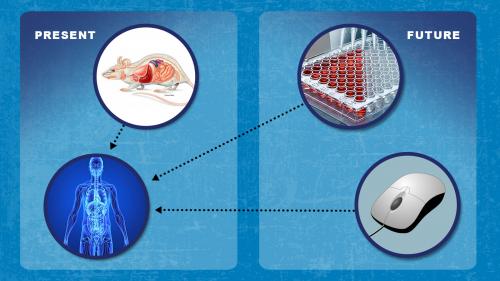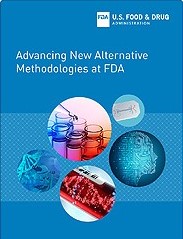Advancing Alternative Methods at FDA

Read about the activities FDA scientists are undertaking to spur the development of new regulatory approaches that can help improve predictivity--and potentially replace, reduce and/or refine animal testing.
FDA’s Alternative Methods Working Group
Background
Advances in systems biology, stem cells, engineered tissues, and mathematical modeling are creating unique opportunities to improve FDA's predictive ability, potentially enhancing our ability to predict risk and efficacy.
These advances may help bring FDA-regulated products to market faster, with improved efficacy, or prevent products with increased toxicological risk from reaching the market. Also critical is the potential for these advances to replace, reduce, and/or refine animal testing.
FDA has had a long-standing commitment to promote the development and use of new technologies to better predict human and animal responses to substances relevant to its regulatory mission. As part of efforts to further the goals of the FDA Predictive Toxicology Roadmap, FDA launched its Alternative Methods Working Group (Alternative Methods Group).
Most recently, in its 2021: Advancing Regulatory Science at FDA: Focus Areas of Regulatory Science (FARS) report, FDA outlined areas that it has identified as needing continued targeted investment in regulatory science research to foster the development of innovative products, provide data and methods to inform regulatory decision-making, and improve guidance to sponsors. Advancing Novel Technologies to Improve Predictivity of Non-clinical Studies and Replace, Reduce, and Refine Reliance on Animal Testing is one of those priority areas, under the focus area Increasing Choice and Competition Through Innovation (for questions about the FARS initiative, please contact [email protected]).
FDA invites developers to showcase their cutting-edge technologies in FDA Webinar Series on Alternative Methods
FDA's Alternative Methods Group focuses on opportunities for evolving and innovative technologies to advance useful tools as well as new areas of science to support alternative methods to traditional toxicity and efficacy testing that extend across FDA’s product areas.
It also acts as a catalyst to foster the development and potential application of alternative systems (in vitro, in vivo, in silico, and systems toxicology modeling), such as microphysiological systems, to support decision-making in regulatory toxicology.
The Alternative Methods Group facilitates interactions with global regulatory bodies interested in implementing alternative methods in toxicology. Additionally, it examines opportunities and viable ways by which emerging methods and new technologies can support regulatory review of risk, safety, and efficacy of FDA-regulated products.
The activities of FDA's Alternative Methods Group are informational and do not serve as official regulatory guidance.
Objectives of FDA's Alternative Methods Working Group
- Discuss FDA-wide new in vitro, in vivo, and in silico methods, including research, training, and communication.
- Interact with U.S. Federal partners and other global stakeholders to facilitate discussion and development of draft performance criteria for such assays.
- Establish a dialogue and develop partnerships with FDA stakeholders to explore regulatory science applications for such technologies.
- Identify the performance criteria of microphysiological systems by engaging with FDA experts and FDA stakeholders through public-private partnerships.
FDA Definitions
Microphysiological System (MPS):: A microphysiological system uses microscale cell culture platform for in vitro modeling of functional features of a specific tissue or organ of human or animal origin by exposing cells to a microenvironment that mimics the physiological aspects important for their function or pathophysiological condition. MPS design may aim to provide and support cultured cells with physical (e.g., temperature, pH and oxygen)/biochemical/electrical/mechanical (e.g., flow or stretch)/structural/morphological conditions and recapitulate a set of specific properties that define a healthy or diseased organ or tissue function. MPS platforms may comprise mono-cultures, co-cultures of multiple cell types, maintenance of explants derived from tissues/organs, and/or inclusion of organoid cell formations.
Organ-on-a-chip: Organ-on-a-chip is a subset class of microphysiological systems and consists of a miniaturized physiological environment engineered to yield and/or analyze functional tissue units capable of modeling specified/targeted organ-level responses.
Contact Us:
Resources for You
FDA's Predictive Toxicology Roadmap
Medical Device Development Tools (MDDT)
Catalog of Regulatory Science Tools to Help Assess New Medical Devices

